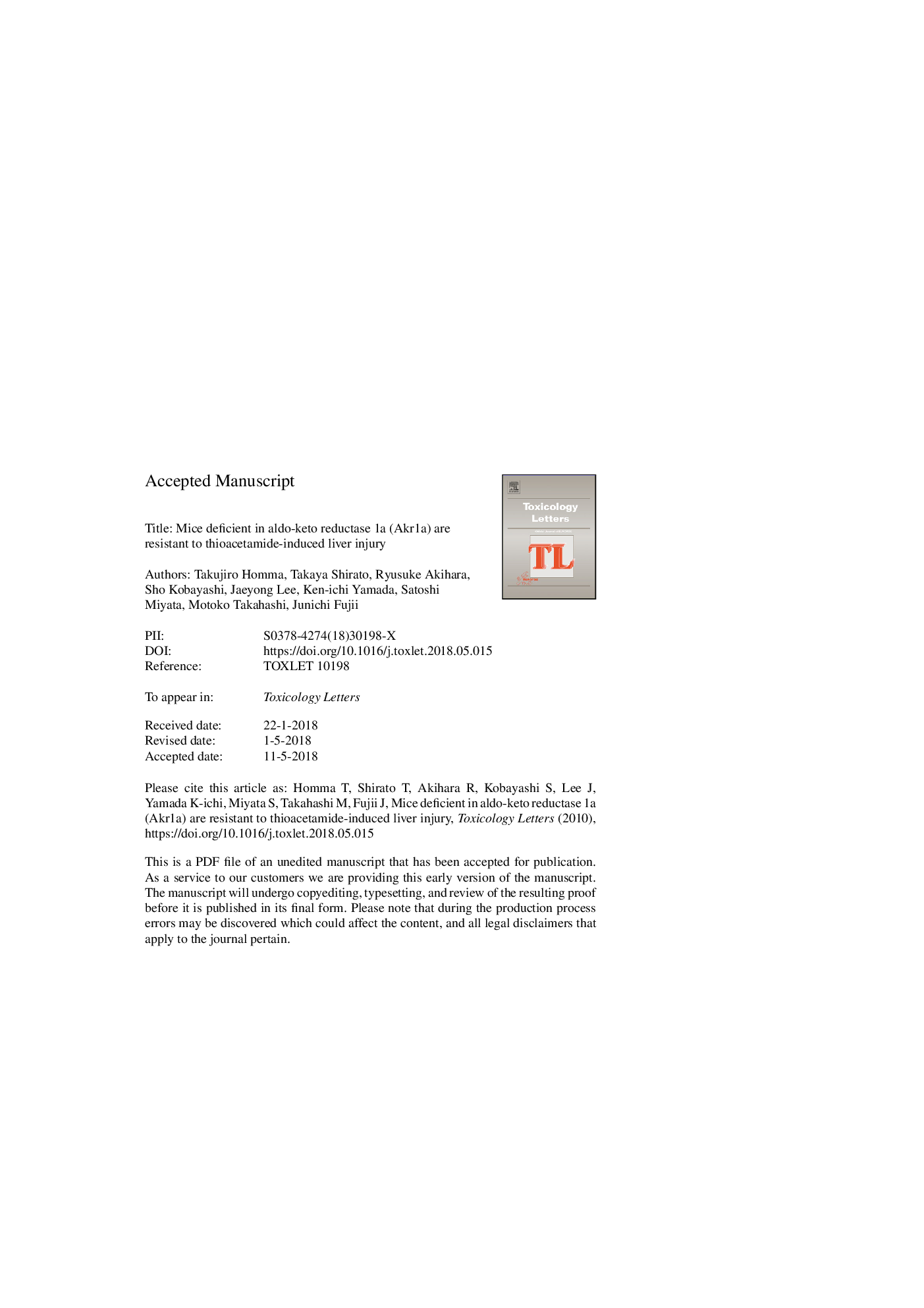| کد مقاله | کد نشریه | سال انتشار | مقاله انگلیسی | نسخه تمام متن |
|---|---|---|---|---|
| 8553105 | 1562578 | 2018 | 29 صفحه PDF | دانلود رایگان |
عنوان انگلیسی مقاله ISI
Mice deficient in aldo-keto reductase 1a (Akr1a) are resistant to thioacetamide-induced liver injury
دانلود مقاله + سفارش ترجمه
دانلود مقاله ISI انگلیسی
رایگان برای ایرانیان
کلمات کلیدی
ALTCyPPRXPBSTAAJnki.p.ASAUPRSOD1c-Jun N-terminal kinase - C-Jun N-terminal kinaseH&E - H & EROS - ROSAscorbic acid - آسکوربیک اسیدLiver injury - آسیب کبدیalanine transaminase - آلانین ترانس آمینازAldehyde reductase - آلدهید ردوکتازEndoplasmic reticulum stress - استرس شبکه آندوپلاسمیTransgenic - تراریختهCHOP - تکه کردنThioacetamide - تیوات آمیدIntraperitoneally - داخل صفاقیsuperoxide dismutase 1 - سوپر اکسید دیسموتاز 1Cytochrome P450 - سیتوکروم پی۴۵۰endoplasmic reticulum - شبکه آندوپلاسمی lactate dehydrogenase - لاکتات دهیدروژناز LDH - لاکتات دهیدروژناز به صورت مختصر شده LDH Phosphate-buffered saline - محلول نمک فسفات با خاصیت بافریwild-type - نوع وحشیHematoxylin and Eosin - هماتوکسیلین و ائوزینUnfolded protein response - پاسخ پروتئین آشکارCCAAT-enhancer-binding protein homologous protein - پروتئین همولوگ زدن پروتئین پروتئین تقویت کننده CCAATPeroxiredoxin - پروکسی ردوکسینReactive oxygen species - گونههای فعال اکسیژن
موضوعات مرتبط
علوم زیستی و بیوفناوری
علوم محیط زیست
بهداشت، سم شناسی و جهش زایی
پیش نمایش صفحه اول مقاله

چکیده انگلیسی
Aldehyde reductase (Akr1a) has been reported to be involved in detoxification of reactive aldehydes as well as in the synthesis of bioactive compounds such as ascorbic acid (AsA). Because Akr1a is expressed at high levels in the liver and is involved in xenobiotic metabolism, our objective was to investigate the hepato-protective role of Akr1a in a thioacetamide (TAA)-induced hepatotoxicity model using Akr1a-deficient (Akr1aâ/â) mice. Wild-type (WT) and Akr1aâ/â mice were injected intraperitoneally with TAA and the extent of liver injury in the acute phase was assessed. Intriguingly, the extent of TAA-induced liver damage was less in the Akr1aâ/â mice than in the WT mice. Biomarkers for the ER stress-induced apoptosis pathway were markedly decreased in the livers of Akr1aâ/â mice, whereas AsA levels in plasma did not change significantly in any of the mice. In the liver, TAA is converted to reactive metabolites such as TAA S-oxide and then to TAA S, S-dioxide via the action of CYP2E1. In Akr1aâ/â mice, CYP2E1 activity was relatively lower than WT mice at the basal level, leading to reactive TAA metabolites being produced at lower levels after the TAA treatment. The levels of liver proteins that were modified with these metabolites were also lower in the Akr1aâ/â mice than the WT mice after the TAA treatment. Furthermore, after a lethal dose of a TAA challenge, the WT mice all died within 36â¯h, whereas almost all of the Akr1aâ/â mice survived. These collective results suggest that Akr1aâ/â mice are resistant to TAA-induced liver injury, and it follows that the absence of Akr1a might modulate TAA bioactivation.
ناشر
Database: Elsevier - ScienceDirect (ساینس دایرکت)
Journal: Toxicology Letters - Volume 294, 15 September 2018, Pages 37-43
Journal: Toxicology Letters - Volume 294, 15 September 2018, Pages 37-43
نویسندگان
Takujiro Homma, Takaya Shirato, Ryusuke Akihara, Sho Kobayashi, Jaeyong Lee, Ken-ichi Yamada, Satoshi Miyata, Motoko Takahashi, Junichi Fujii,